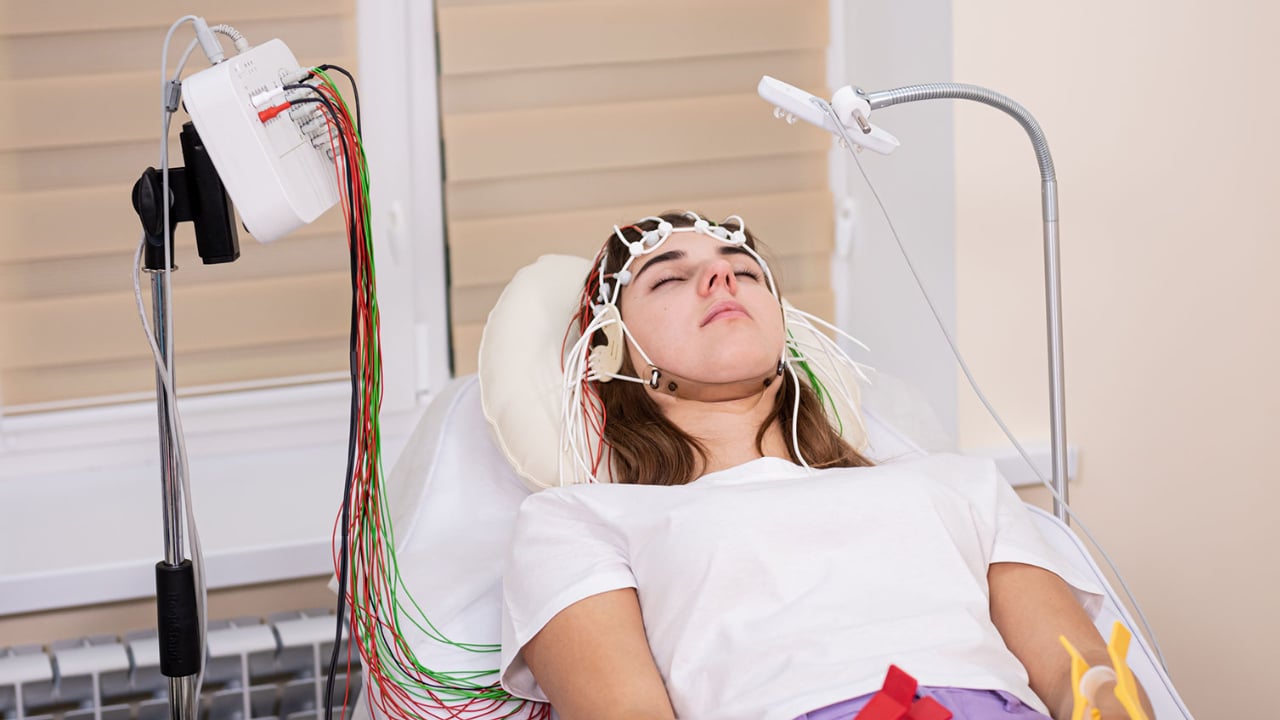Dement, W., & Kleitman, N. (1957). The relation of eye movements during sleep to dream activity: an objective method for the study of dreaming. Journal of Experimental Psychology, 53 (5), 339.
Aim
Dement and Kleitman’s research aimed to find objective methods to demonstrate a relationship between dream content and physiological indicators of dreaming.
Specifically, they wanted to investigate:
- Does dream recall differ between REM and nREM stages of sleep
- Is there a positive correlation between subjective estimates of dream duration and the length of the REM period before waking?
- Are eye movement patterns related to dream content?

Procedure
Dement and Kleitman (1957) is a classic study which explored sleep and dreaming using electronic recording as well as observation and diary methods. It is summarised in the box opposite.
7 male and 2 female participants, 5 of these studied in detail.
During the day, the participant ate normally (excluding coffee and alcohol) and then arrived at the laboratory just before their normal bedtime.
The participant went to sleep with electrodes attached beside the eyes (EOG) and on the scalp (EEG), which were fed to the experimenter’s room.
What is an Electroencephalograph (EEG)
The EEG is a machine that can detect and record minute changes in voltage associated with electrical activity in nerve and muscle cells when many are active at the same time. This is recorded using microelectrodes (large, flat electrodes stuck to the skin or scalp).
It produces a chart (an encephalogram) that shows how ‘brain waves’ vary, i.e., how the frequency and amplitude (height) of electrical output from the brain change over time.
In addition, an EEG can be used to record the frequency of eye movements by attaching electrodes to the skin beside each eye. This is called an Electo-occulograph (EOG).
Participants were woken (by a doorbell) at various times during the night, asked to describe their dream if they were having one, then returned to sleep.
IV 1: Occurrence of Sleep Stage
- Participants were woken either in REM or nREM (but not told which). They confirmed whether they were having a dream and described the content into a recorder.
IV 2: Duration of REM Sleep
- Participants were awoken after either 5 or 15 minutes of REM sleep. They chose which duration they had been woken up after. Longer REM periods were also allowed.
- The number of words in the dream narrative was counted (although this was affected by how expressive the participant was).
IV 3: Pattern of Eye Movement during REM Sleep
- The direction of eye movements was detected using electrodes around the eyes.
- Participants were woken after the persistence of a single eye movement pattern for more than one minute and asked to report their dream.
- The eye movement patterns were: mainly vertical, mainly horizontal, both vertical and horizontal, and very little or no movement.
Findings
Uninterrupted dream stages lasted 3 – 50 minutes (mean approx 20 minutes), were typically longer later in the night and showed intermittent bursts of around 2- 100 REMs.
The cycle length varied between participants but was consistent within individuals, eg 70 for one, 104 for another.
When woken in nREM participants returned to nREM, but when woken in REM they typically didn’t dream again until the next REM phase (except sometimes in the final REM phase).
- Participants frequently described dreams when woken in REM but rarely did from nREM sleep (although there were some individual differences), and these differences were marked at the end of the nREM period (within 8 minutes of cessation of REM – only 6 dreams recalled in 132 awakenings). In nREM awakenings, participants tended to describe feelings but not specific dream content.
- The accuracy of estimation of 5 or 15 minutes of REM was very high (88% and 78%, respectively). REM duration and the number of words in the narrative were significantly positively correlated.
- Eye movement patterns were related to dream content, eg horizontal movements in a dream about throwing tomatoes, vertical ones in a dream about ladders, and a few movements in dreams about staring fixedly at something.
Conclusion
Dreaming is reported from REM but not nREM sleep; participants can judge the length of their dream duration and REM patterns related to dream content.
Critical Evaluation
This study was a laboratory experiment. Laboratory studies have high levels of control over variables but may lack ecological validity (see below). The study used electroencephalography (EEG) to measure brain activity and this allows precise measurements to be taken.
The data collected in this study by mostly quantitative. In relation to the first two research questions, the data is simply numbers of participants who could or could not recall dreams or could or could not accurately estimate the length of their dreams.
Quantitative data is relatively easy to collect and can be analyzed statistically. However, it reduces complex qualitative phenomena to numbers and this often results in a lack of detail in the data.
The data collected in relation to the third question was more qualitative, as here, participants were asked to describe the contents of their dreams. This gives us richer and more interesting data but such data is difficult to use for comparisons and is hard to analyze statistically.
Was the sample representative?
The sample was very small indeed. Only nine participants were studied in total and only five of these were studied intensively. This is a very small number of participants to generalize from.
You could argue that physiological processes are likely to be the same in all people but this may not be the case.
It is possible that sleep patterns and in particular, relationships between eye movements and dreaming, vary from person to person and the conclusions drawn from Dement and Kleitman’s research would be strengthened if the same relationships were established in a larger sample of people.
Was the study ecologically valid?
The research studied participants who went to sleep in a laboratory with electrodes stuck to their heads. It is unlikely that this bears much relation to sleep in a normal environment!
It is possible that being in such an artificial condition meant that their sleep was disturbed, and if this was the case, the researchers would not have been studying normal sleep patterns.
The participants were also woken up several times during the night and asked about their dreams. Again, this is unlikely to happen normally and may have had an effect on the way the participants slept.
However, research conducted outside of the controlled conditions of the laboratory would have been unable to measure brain activity and eye movements in the ways.
Was the study useful?
The conclusions that were reached by Dement and Kleitman have been replicated by many other researchers. However, there is one methodological issue that should be considered.
In relation to the first research question, Dement and Kleitman conclude that dreaming takes place in REM rather than non-REM sleep.
What they have actually demonstrated is that dreams are recalled more often from REM rather than non-REM sleep and it may be that dreaming does occur in non-REM sleep, and it is much harder to recall them.
When the research was first conducted, very little was known about the relationship between eye movements and dreaming and so Dement and Kleitman’s research really did add new information to what was known about sleep. It is difficult, nearly fifty years later, to understand what a major breakthrough this study represented.
The use of EEG to record brain activity whilst sleeping was also relatively new, and it was not until research like this Core Study that it became clear that dreams could be studied in an objective way.
Dement and Kleitman’s research generated very many other studies into sleep and dreaming and there have been many useful findings.

